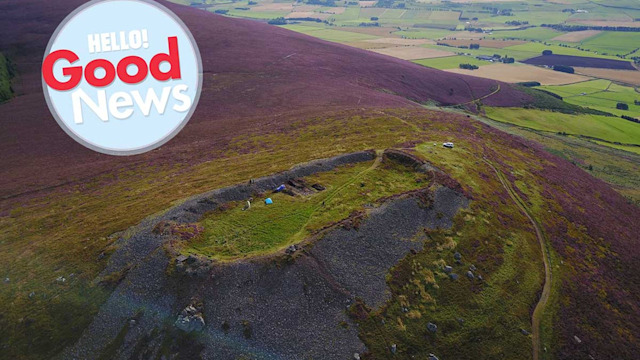An ancient hillfort in Aberdeenshire has been discovered by archaeologists – and is the biggest settlement of its kind ever unearthed in Scotland! The researchers, from the University of Aberdeen, uncovered evidence that up to 4,000 native Scots would have lived in more than 800 huts perched on the Top O'Noth hill near the village of Rhynie. Carbon dating suggests the fort, of around 17 acres, was built in the 5th or 6th century, and could even date as far back as the 3rd – meaning it is likely to be Pictish in origin. The discovery means that the area once had a hilltop settlement that, at its height, could have rivalled the largest known post-Roman settlements in Europe.
SEE THE PICS: William Wallace's forgotten fort rediscovered
The site is the largest of its kind ever found in Scotland
Professor Gordon Noble, who led the research, described the discovery as the 'most surprising of his career' – as the hillfort had been assumed to date from the Bronze or Iron Age. "I was absolutely stunned when I read the results," he said. "This makes it bigger than anything we know from early medieval Britain – the previous biggest known fort in early medieval Scotland is Burghead at around five and a half hectares and in England famous post-Roman sites such as Cadbury Castle is seven hectares and Tintagel around five hectares."
The team from University of Aberdeen have been researching the area since 2011
Professor Noble believes the discovery shakes the narrative of what historians know about the time period. Historians had previously assumed that urban-style settlements if this size didn't occur until the 12th century in Scotland. "It is truly mind blowing and demonstrates just how much we still have to learn about settlement around the time that the early kingdoms of Pictland were being consolidated," he added. The team have been carrying out extensive fieldwork in the surrounding area since 2011, but had previously focused on the lower valley, long noted for its Pictish heritage thanks to the famous Rhynie Man standing stone found on Barflat farm.
READ MORE: Is ITV's Belgravia historically accurate?
Who were the Picts?
The Picts were a collection of tribes living in northern Scotland around 270-900 AD. Research shows they were an artistic, hardworking and clever people with skills in fishing and farming. They're thought to have lived peacefully among each other, but were fierce warriors who fought off the Romans – Rome never conquered Pictish lands.
A Pictish carved stone dating back to the 6th century
Unusually, they were a matrilineal society, with kinship passed down through the mother. There's little record of their history, and what is known comes from Roman and Scottish writers, and from images the Picts themselves carved on stones. They survived as a distinct people until the 10th century, when its widely thought they became the largest population within the nation of Scotti, Picts, Britons and Angles – what we now call Scotland.
Do you have some Good News you'd like to shout about? Email our Good News ambassador Toff at toff@hellomagazine.com to share your story and visit our Good News channel for more feel-good stories.
